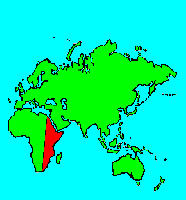SPECIES INFO
The common reed frog (Hyperolius viridiflavus) is found from Ethiopia south through Uganda and into parts of Zaire, and east into Tanzania and Kenya. This small frog is usually about one inch in body length (2.5 cm). Although the pattern is variable, this green to brown frog will show very small yellow or red spots.The Hyperolius frog genus is found in Africa south of the northern desert regions. There are 32 species represented in Uganda, Tanzania, and Kenya. Additional species are found in western Africa. These are small colorful frogs usually less than 3.5 cm in length. Many species have variable color patterns. Sexual color dimorphism is also common.
The tree frog Hyperoliidae is a large family of frogs found primarily in Africa. These frogs are generally capable of climbing into vegetation, and these frogs are generally brightly colored.
Order Anura contains the jumping amphibians such as the frogs and the toads. Chris Mattison in Frogs and Toads of the World published in 1992 gives a very good overview of this group of amphibians. He states that there are 3,445 species in 310 different genera that he believes should fall into 21 different families. The three largest families, in terms of species, are the Ranidae (Typical frogs) with 667 species, the Hylidae (tree frogs) with 630 species, and the Leptodactylidae (small to medium Neotropical frogs) with 710 species. The Bufonidae (true toads) has 335 species.
In 2011 Chris Mattison published a new work under a similar title that appears slightly different by different publishers. In this book he states that the number of species of frogs and toads in the world is now at 5,858. However, he further notes that this group of animals is in serious trouble on a world wide basis. He notes that in 2008 the IUCN noted that 398 species were critically endangered (with 37 of those probably extinct), 650 endangered, and 578 vulnerable.
Amphibians (Class Amphibia) are best known as the frogs, toads, and salamanders. Amphibians begin their life as larvae that live in the water. Some species continue to evolve so that the final forms can breathe air. A typical example, is the Bullfrog of North America that begins life as a tadpole, and then finally turns into a adult frog. Amphibians usually have a soft, moist skin, and four legs adapted for walking or jumping or climbing. They have a three-chambered heart which gives them a fairly advanced circulatory system. There are probably about 2,500 species in this class.
Backboned Animals (Phylum Chordata) are the most advanced group of animals on earth. These animals are characterized by having a spinal cord or backbone. Most members have a clearly defined brain that controls the organism through a spinal cord. Fish, amphibians, reptiles, birds, and mammals are in this phylum.
Currently, some taxonomists believe that the fish should be divided into two groups (sharks and regular fishes) and that there are some other primitive groups in the phylum such as hagfish or lampreys.
Animal Kingdom contains numerous organisms that feed on other animals or plants. Included in the animal kingdom are the lower marine invertebrates such as sponges and corals, the jointed legged animals such as insects and spiders, and the backboned animals such as fish, amphibians, reptiles, birds, and mammals.

